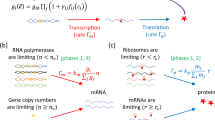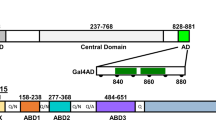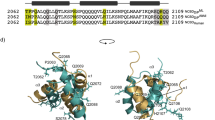Abstract
The solution structure and backbone dynamics of the transcriptional activator PUTS (31–100) has been characterized using NMR spectroscopy. PUT3 (31–100) contains three distinct domains: a cysteine zinc cluster, linker, and dimerization domain. The cysteine zinc cluster of PUT3 closely resembles the solution structure of GAL4, while the dimerization domain forms a long coiled-coil similar to that observed in the crystal structures of GAL4 and PPR1. However, the residues at the N-terminal end of the coiled-coil behave very differently in each of these proteins. A comparison of the structural elements within this region provides a model for the DMA binding specificity of these proteins. Furthermore, we have characterized the dynamics of PUT3 to find that the zinc cluster and dimerization domains have very diverse dynamics in solution. The dimerization domain behaves as a large protein, while the peripheral cysteine zinc clusters have dynamic properties similar to small proteins.
This is a preview of subscription content, access via your institution
Access options
Subscribe to this journal
Receive 12 print issues and online access
$189.00 per year
only $15.75 per issue
Buy this article
- Purchase on Springer Link
- Instant access to full article PDF
Prices may be subject to local taxes which are calculated during checkout
Similar content being viewed by others
References
Brandriss, M.C. & Magasanik, B. Genetics and physiology of proline utilization in Saccharomyces cerevisiae: enzyme induction by proline. J. Bacteriol. 140, 498–503 (1979).
Brandriss, M.C. & Magasanik, B. Genetics and physiology of proline utilization in Saccharomyces cerevisiae: mutation causing constitutive enzyme expression. J. Bacterial. 140, 504–507 (1979).
Brandriss, M.C. & Magasanik, B. Proline: an essential intermediate in arginine degradation in Saccharomyces cerevisiae. J. Bacteriol. 143, 1403–1410 (1980).
Brandriss, M.C. Evidence for positive regulation of the proline utilization pathway in Saccharomyces cerevisiae. Genetics 117, 429–435 (1987).
Schjerling, P. & Holmberg, S. Comparative amino acid sequence analysis of the Q zinc cluster family of transcriptional regulators. Nucleic Acids Res. 24, 4599–4607 (1996).
Marmorstein, R., Carey, M., Ptashne, M. & Harrison, S.C. DNA recognition by GAL4: Structure of a protein-DNA complex. Nature 356, 408–414 (1992).
Marmorstein, R. & Harrison, S.C. Crystal structure of a PPR1-DNA complex: DNA recognition by proteins containing a Zn2Cys6 binuclear cluster. Genes Dev. 8, 2504–2512 (1994).
Baleja, J.D., Marmorstein, R., Harrison, S.C. & Wagner, G. Solution structure of the DMA-binding domain of Cd2-GAL4 from Saccharomyces cerevisiae. Nature 356, 450–453 (1992).
Kraulis, P.J., Raine, A.R.C., Gadhavi, P.L., Laue, E.D. Structure of the DNA binding domain of zinc GAL4. Nature 356, 448–450 (1992).
Shirakawa, M., Fairbrother, W.J., Serikawa, Y., Ohkubo, T., Kyogoku, Y. & Wright, P.E. Assignment of 1H, 15N, and 13C resonances, identification of elements of secondary structure and determination of the global fold of the DNA-binding domain of GAL4. Biochemistry 32, 2144–2153 (1993).
Gardner, K. H., Anderson, S. F., & Coleman, J. E. Solution structure of the Kluyveromyces lactis LAC9 Cd2Cys6 DNA-binding domain. Nature Struct. Biol. 2, 898–905 (1995).
Timmerman, J., Vuidepot, A.-L., Bontems, F., Lallemand. J.-Y, Gervais, M., Shechter, E. & Guiard, B. 1H, 15N resonance assignment and three-dimensional structure of CYP1 (HAP1) DNA-binding domain. J. Mol. Biol. 259, 792–804 (1996).
Reece, R.J. & Ptashne, M. Determinants of binding-site specificity among yeast C6 zinc cluster proteins. Science 261, 909–911 (1993).
Peng, J.W. & Wagner, G. Frequency spectrum of NH bonds eglin c from spectral density mapping at multiple fields. Biochemistry 34, 16733–16752 (1995).
Ishima, R. & Nagayama, K. Protein backbone dynamics revealed by quasi spectral density function analysis of amide N-15 nuclei. Biochemistry, 34, 3162–3171 (1995).
Ishima, R. & Nagayama, K. Quasi-spectral-density function analysis for nitrogen-15 nuclei in proteins. J. Magn. Reson. B108, 73–76 (1995).
Farrow, N.A., Zhang, O., Forman-Kay, J.D. & Kay, L.E. Comparison of the backbone dynamics of a folded and an unfolded SH3 domain existing in equilibrium in aqueous buffer. Biochemistry 34, 868–878 (1995).
Lefévre, J.-F., Dayie, K. T., Peng, J. W. & Wagner, G. Internal mobility in the partially folded DNA binding and dimerization domains of GAL4: NMR analysis of the N-H spectral density functions. Biochemistry 35, 2674–2686 (1996).
Brünger, A.T. (1993) XPLOR Version 3.1: A System for X-ray Crystallography and NMR, Yale University Press, New Haven.
Nilges, M. A calculation strategy for the structural determination of symmetric dimers by 1H NMR Proteins 17, 297–309 (1993).
Morris, A.L., MacArthur, M.W., Hutchinson, E.G. & Thornton, J.M. Stereochemical quality of protein structure coordinates. Proteins 12, 345–364 (1992).
Nicholls, A.J. (1993) GRASP Manual. Columbia University, New York.
Nirmala, N.R. & Wagner, G. Measurements of 13C relaxation times in proteins by two-dimensional heteronuclear 1H-13C correlation spectroscopy. J. Am. Chem. Soc. 110, 7557–7558 (1988)
Nirmala, N.R. & Wagner, G. Measurements of 13C spin-spin relaxation times by two-dimensional heteronuclear 1H-13C correlation spectroscopy. J. Magn. Resort. 82, 659–661 (1989).
Peng, J.W. & Wagner, G. Mapping of spectral density functions using heteronuclear NMR relaxation measurements. J. Magn. Reson. 98, 308–332 (1992a).
Peng, J.W. & Wagner, G. Mapping of spectral densities of N-H bond motions in Eglin c using heteronuclear relaxation experiments. Biochemistry 31, 8571–8586 (1992b).
Phan, I.Q.H., Boyd, J. & Campbell, I.D. Dynamic studies of a fibronectin type I module pair at three frequencies anisotropic modelling and direct determination of conformational exchange, J. Biomol. NMR 8, 369–378 (1996).
Walters, K.J., Matsuo, H. & Wagner, G. A simple method to distinguish intermonomer NOEs in homodimeric proteins with Cz symmetry. J. Am. Chem. Soc, 119, 5958–5959.(1997).
States, D.J., Haberkorn, R.A. & Ruben, D.J. A two-dimensional nuclear Overhauser experiment with pure absorption phase in four quadrants. J. Magn. Reson. 48, 286–292 (1982).
Bartels, C., Xia, T.-H., Billeter, M. Guntert, P. & W¨thrich, K. The program XEASY for the computer-supported NMR spectral analysis of biological macromolecules. J. Biomol. NMR 6, 1–10.
Wüthrich, K. 1986. NMR of Proteins and nucleic acids. New York: John Wiley & Sons.
Kay, L.E., Ikura, M., Tschudin, R, Bax, A. Three-dimensional triple-resonance NMR spectroscopy of isotropically enriched proteins. J. Magn. Reson. 89, 496–514 (1990).
Bax, A. & Ikura, M. An efficient 3D NMR technique for correlating the proton and 15N backbone amide resonances with the α-carbon of the preceding residue in uniformly 15N/13Cenriched proteins. J. Biomol. NMR 1, 99–104 (1991).
Grzesiek, S. & Bax, A. Improved 3D triple-resonance NMR techniques applied to a 31 kDa protein. J. Magn. Reson. 96, 432–440 (1992).
Bax, A., Clore, G.M. & Gronenborn, A.M. 1H-1H correlation via isotropic mixing of 13C magnetization, a new three-dimensional approach for assigning 1H and 13C spectra of 13C-enriched proteins. J. Magn. Reson. 88, 425–431 (1990).
Marion, D., Driscoll, P.C., Kay, L.E., Wingfield, P.T., Bax, A., Gronenborn, A. M, Clore, G. M. Overcoming the overlap problem in the assignment of 1H NMR spectra of larger proteins by use of three-dimensional heteronuclear 1H-15N Hartmann-Hahn-multiple quantum coherence and nuclear Overhauser-multiple quantum coherence spectroscopy: Application to interleukin 1β. Biochemistry 28, 6150–6156 (1989).
Marion, D., Kay, L.E., Sparks, S.W., Torchia, D.A., Bax, A. Three-dimensional heteronuclear NMR of 15N-labeled proteins. J. Am. Chem. Soc. 111, 1515–1517 (1989b).
Marion, D. & Bax, A.P. COSY, a sensitive alternative for double-quantum-filtered COSY J.Magn. Reson. 80, 528–533 (1988).
Braunschweiler, L. & Ernst, R.R. Coherence transfer by isotropic mixing: application to proton correlation spectroscopy. J. Magn. Reson. 53, 521–528 (1983).
Bax, A. Davis, D.G. MLEV-17-based two-dimensional homonuclear magnetization transfer spectroscopy. J. Magn. Reson. 65, 355–360 (1985).
Vuister, G.W. & Bax, A. Quantitative J correlation: a new approach for measuring homonuclear three-bond J(HNHα) coupling constants in 15N-enriched proteins. J. Am. Chem. Soc. 115, 7772–7777 (1993).
Archer, S.J., Ikura, M., Torchia, D.A. & Bax, A. An alternative 3D NMR technique for correlating backbone 1SN with side chain Hβ resonances in larger proteins. J. Magn. Reson. 95, 636–641 (1991).
Frey, M.H., Wagner, G., Vasák, M., Sørensen, O.W., Neuhaus, D., Wörgötter, E., Kägi, J.H.R., Ernst, R.R. & Wüthrich, K. Polypeptide-metal connectivities in metallothionein 2 by novel 1H-113Cd two-dimensional NMR experiments. J. Am. Chem. Soc. 107, 6847–6859 (1985).
Dayie, K.T. & Wagner, G. Relaxation-rate measurements for 15N-1H groups with pulsed-f ield gradients and preservation of coherence pathways. J. Magn. Reson. A 111, 121–126 (1994).
Farrow, N.A., Muhandiram, R., Singer, A.U., Pascal, S.M., Kay, C. M., Gish, G., Shoelson, S. E., Pawson, T., Forman-Kay, J. D., Kay, L. E. Backbone dynamics of a free and phosphopeptide-compiexed Src homolgy 2 domain studied by 15N NMR relaxation. Biochemistry 33, 5984–6003 (1994).
Markus, M.A., Dayie, K.T., Matsudaira, P. & Wagner, G. Local mobility within Villin 14T probed via heteronuclear relaxation measurements and a reduced spectral density mapping. Biochemistry 33, 1722–1732 (1996).
Kraulis, P. MOLSCRIPT: A program to produce both detailed and schematic plots of protein structures. J.Appl. Crystallogr. 24, 946–950 (1991).
Author information
Authors and Affiliations
Rights and permissions
About this article
Cite this article
Walters, K., Dayie, K., Reece, R. et al. Structure and mobility of the PUT3 dimer. Nat Struct Mol Biol 4, 744–750 (1997). https://doi.org/10.1038/nsb0997-744
Received:
Accepted:
Issue Date:
DOI: https://doi.org/10.1038/nsb0997-744
This article is cited by
-
Improved and expanded Q-system reagents for genetic manipulations
Nature Methods (2015)
-
Orientation-specific signalling by thrombopoietin receptor dimers
The EMBO Journal (2011)
-
Regulation of pentose utilisation by AraR, but not XlnR, differs in Aspergillus nidulans and Aspergillus niger
Applied Microbiology and Biotechnology (2011)
-
Identification of the transmembrane dimer interface of the bovine papillomavirus E5 protein
Oncogene (2001)
-
Linkers made to measure
Nature Structural Biology (1997)



